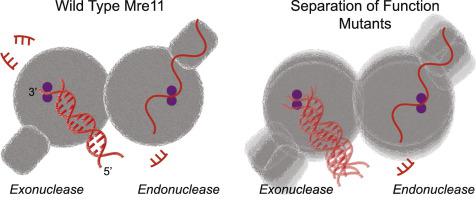当前位置:
X-MOL 学术
›
J. Mol. Biol.
›
论文详情
Our official English website, www.x-mol.net, welcomes your
feedback! (Note: you will need to create a separate account there.)
Mutation of Conserved Mre11 Residues Alter Protein Dynamics to Separate Nuclease Functions.
Journal of Molecular Biology ( IF 4.7 ) Pub Date : 2020-04-01 , DOI: 10.1016/j.jmb.2020.03.030 Samiur Rahman 1 , Mahtab Beikzadeh 1 , Marella D Canny 1 , Navneet Kaur 1 , Michael P Latham 1
Journal of Molecular Biology ( IF 4.7 ) Pub Date : 2020-04-01 , DOI: 10.1016/j.jmb.2020.03.030 Samiur Rahman 1 , Mahtab Beikzadeh 1 , Marella D Canny 1 , Navneet Kaur 1 , Michael P Latham 1
Affiliation

|
Naked and protein-blocked DNA ends occur naturally during immune cell development, meiosis, and at telomeres as well as from aborted topoisomerase reactions, collapsed replication forks, and other stressors. Damaged DNA ends are dangerous in cells and if left unrepaired can lead to genomic rearrangement, loss of genetic information, and eventually cancer. Mre11 is part of the Mre11-Rad50-Nbs1 complex that recognizes DNA double-strand breaks and has exonuclease and endonuclease activities that help to initiate the repair processes to resolve these broken DNA ends. In fact, these activities are crucial for proper DNA damage repair pathway choice. Here, using Pyrococcus furiosus Mre11, we question how two Mre11 separation-of-function mutants, one previously described but the second first described here, maintain endonuclease activity in the absence of exonuclease activity. To start, we performed solution-state NMR experiments to assign the side-chain methyl groups of the 64-kDa Mre11 nuclease and capping domains, which allowed us to describe the structural differences between Mre11 bound to exo- and endonuclease substrates. Then, through biochemical and biophysical characterization, including NMR structural and dynamics studies, we compared the two mutants and determined that both affect the dynamic features and double-stranded DNA binding properties of Mre11, but in different ways. In total, our results illuminate the structural and dynamic landscape of Mre11 nuclease function.
中文翻译:

保守的Mre11残基的突变改变蛋白质动力学以分离核酸酶功能。
裸露的和蛋白封闭的DNA末端在免疫细胞发育,减数分裂和端粒中自然发生,以及因拓扑异构酶反应异常,复制叉塌陷和其他应激因素而自然发生。受损的DNA末端在细胞中是危险的,如果不进行修复会导致基因组重排,遗传信息丢失,并最终导致癌症。Mre11是Mre11-Rad50-Nbs1复合体的一部分,该复合体识别DNA双链断裂,并具有核酸外切酶和核酸内切酶活性,有助于启动修复过程来解决这些断裂的DNA末端。实际上,这些活动对于正确选择DNA损伤修复途径至关重要。在这里,我们使用激烈热球菌Mre11质疑两个Mre11功能分离突变体,一个在前面描述过,而第二个在这里描述了,在没有核酸外切酶活性的情况下保持核酸内切酶活性。首先,我们进行了溶液状态NMR实验,以指定64-kDa Mre11核酸酶和封端域的侧链甲基,这使我们能够描述与外切核酸酶和内切核酸酶底物结合的Mre11之间的结构差异。然后,通过生化和生物物理表征(包括NMR结构和动力学研究),我们比较了这两个突变体,并确定它们都以不同的方式影响Mre11的动力学特征和双链DNA结合特性。总的来说,我们的结果阐明了Mre11核酸酶功能的结构和动态格局。这使我们能够描述与外切核酸酶和内切核酸酶底物结合的Mre11之间的结构差异。然后,通过生化和生物物理表征(包括NMR结构和动力学研究),我们比较了这两个突变体,并确定它们都以不同的方式影响Mre11的动力学特征和双链DNA结合特性。总的来说,我们的结果阐明了Mre11核酸酶功能的结构和动态格局。这使我们能够描述与外切核酸酶和内切核酸酶底物结合的Mre11之间的结构差异。然后,通过生化和生物物理表征(包括NMR结构和动力学研究),我们比较了这两个突变体,并确定它们都以不同的方式影响Mre11的动力学特征和双链DNA结合特性。总的来说,我们的结果阐明了Mre11核酸酶功能的结构和动态格局。
更新日期:2020-04-01
中文翻译:

保守的Mre11残基的突变改变蛋白质动力学以分离核酸酶功能。
裸露的和蛋白封闭的DNA末端在免疫细胞发育,减数分裂和端粒中自然发生,以及因拓扑异构酶反应异常,复制叉塌陷和其他应激因素而自然发生。受损的DNA末端在细胞中是危险的,如果不进行修复会导致基因组重排,遗传信息丢失,并最终导致癌症。Mre11是Mre11-Rad50-Nbs1复合体的一部分,该复合体识别DNA双链断裂,并具有核酸外切酶和核酸内切酶活性,有助于启动修复过程来解决这些断裂的DNA末端。实际上,这些活动对于正确选择DNA损伤修复途径至关重要。在这里,我们使用激烈热球菌Mre11质疑两个Mre11功能分离突变体,一个在前面描述过,而第二个在这里描述了,在没有核酸外切酶活性的情况下保持核酸内切酶活性。首先,我们进行了溶液状态NMR实验,以指定64-kDa Mre11核酸酶和封端域的侧链甲基,这使我们能够描述与外切核酸酶和内切核酸酶底物结合的Mre11之间的结构差异。然后,通过生化和生物物理表征(包括NMR结构和动力学研究),我们比较了这两个突变体,并确定它们都以不同的方式影响Mre11的动力学特征和双链DNA结合特性。总的来说,我们的结果阐明了Mre11核酸酶功能的结构和动态格局。这使我们能够描述与外切核酸酶和内切核酸酶底物结合的Mre11之间的结构差异。然后,通过生化和生物物理表征(包括NMR结构和动力学研究),我们比较了这两个突变体,并确定它们都以不同的方式影响Mre11的动力学特征和双链DNA结合特性。总的来说,我们的结果阐明了Mre11核酸酶功能的结构和动态格局。这使我们能够描述与外切核酸酶和内切核酸酶底物结合的Mre11之间的结构差异。然后,通过生化和生物物理表征(包括NMR结构和动力学研究),我们比较了这两个突变体,并确定它们都以不同的方式影响Mre11的动力学特征和双链DNA结合特性。总的来说,我们的结果阐明了Mre11核酸酶功能的结构和动态格局。











































 京公网安备 11010802027423号
京公网安备 11010802027423号